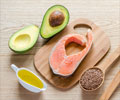Rice Bran Oil as a Healthy Cooking Medium
Rice bran oil indeed has the most desirable fat composition,better frying stability and offers unique health benefits due to the presence of phytosterols and oryzanols.
Like rice bran, groundnut oil too has an ideal fat composition.
Approximate fatty acid composition of dietary fats and oils consumed in India (% of total fatty acids)-
| Fats / oils Recommended ideal fatty acid composition by NIN | SFAs 27-33% | MUFAs 33-40% | LA (Lenolenic acid) | ALA (Alpha lenolenic acid) | Predominant Fatty Acids |
| 27 – 33 % | |||||
| High SFAs | |||||
| Coconut | 92 | 6 | 2 | - | SFA |
| Palm kernel | 83 | 15 | 2 | - | SFA |
| Butter/Ghee | 68 | 29 | 2 | 1 | SFA |
| Palmolein | 39 | 46 | 11 | <0.5 | SFA & MUFA |
| High MUFAs & Moderate LA & Moderate ALA | |||||
| Groundnut | 19 | 41 | 32 | <0.5 | MUFA Close to Recommendations |
| Rice bran | 17 | 43 | 38 | 1 | MUFA Closest to Recommendations High Smoke Point |
| Sesame | 16 | 41 | 42 | <0.5 | MUFA Rich Close to Recommendations |
| Olive | 13 | 76 | 10 | <0.5 | MUFA Close to Recommendations Low Smoke Point |
| High MUFAs & High ALA | |||||
| Canola | 6 | 60 | 22 | 10 | MUFA & Omega 3 Close to Recommendations High Smoke Point |
| Mustard/rapeseed | 4 | 65 | 15 | 14 | MUFA & Omega 3 Contains undesirable erucic acid High Smoke Point |
| High LA | |||||
| Cottonseed | 24 | 29 | 48 | 1 | LA / Omega 6 |
| Corn | 12 | 35 | 50 | 1 | LA / Omega 6 |
| Safflower/Kardi | 9 | 13 | 75 | - | LA / Omega 6 |
| Sunflower | 12 | 22 | 62 | - | LA / Omega 6 |
| High ALA | |||||
| Soybean | 14 | 24 | 53 | 7 | ALA / Omega 3 |
| Flaxseed | 10 | 21 | 16 | 53 | ALA / Omega 3 |
| High TFAs | |||||
| Vanaspati | 46 | 49g | 4 | - | Contains undesirable Trans Fatty acids |
SFA- Saturated Fatty Acids
MCT- Medium chain triglycerides
MUFA- Monounsaturated Fatty acids
PUFA- Polyunsaturated Fatty acids
LA- Linoleic acid
ALA- Alpha linolenic acid
TFAs – Trans Fatty acids
NIN– National Institute of Nutrition
Source: Nutrient Requirements and Recommended Dietary Allowances For Indians, NIN, 2010
- Ideal Fatty Acid Composition of Oils
According to experts “The ratio of SFA: MUFA: PUFA of any oil is very important”. In accordance to the latest recommendations by National Institute of Nutrition (NIN) and Indian Council of Medical Research (ICMR) the ideal fatty acid composition of a oil should be 27-33% : 33-40% : 27-33%. And the fatty acid composition of Rice bran oil comes closest to these recommendations with the percentages at 24: 42: 34.” Rice Bran Oil indeed has the most ideal fat composition, better frying stability and offers unique health benefits due to phytosterols and oryzanols present in it. The other oil which has an ideal fat composition is groundnut oil.
- Smoking Point
The smoking point of a fat is a desirable quality for a cooking medium. Oil very high in PUFA has a low smoking point and oil high in MUFA has a relatively higher smoking point.
The smoke point of various eating oils is important to note because when oils are heated beyond their smoking point they develop free radicals which contribute to risk of cancer. A fat is no longer fit for consumption after it has exceeded its smoke point as it begins to break down. Oils with low smoking point cannot be used for high temperature cooking / frying. Though olive oil is one of the healthiest oil for cooking, by using extra virgin olive oil for frying one is doing more harm than good.
- Non glyceride components of dietary fats and oils
Besides fats, vegetable oils contain non glycerides which have specific health significance-
| Nonglyceride components | Oil | Biological and health function |
| Plant sterols Vitamin A, D, K | All vegetable oils Ghee/butter | Hypocholesterolemic Vitamin |
| Tocopherols | All vegetable oils | Vitamin, Antioxidant |
| Tocotrienols | Palm oil, Rice bran oil | Vitamin, Antioxidant |
| Carotenes | Red Palm oil | Provitamin, Antioxidant |
| Oryzanols | Rice bran oil | Hypocholesterolemic Antioxidant |
| Sesamin | Sesame | Hypocholesterolemic Anti-inflammatory |
| Sesamolin, Sesamol | Sesame | Antioxidant |
Source: Nutrient Requirements and Recommended Dietary Allowances For Indians, NIN, 2010.











